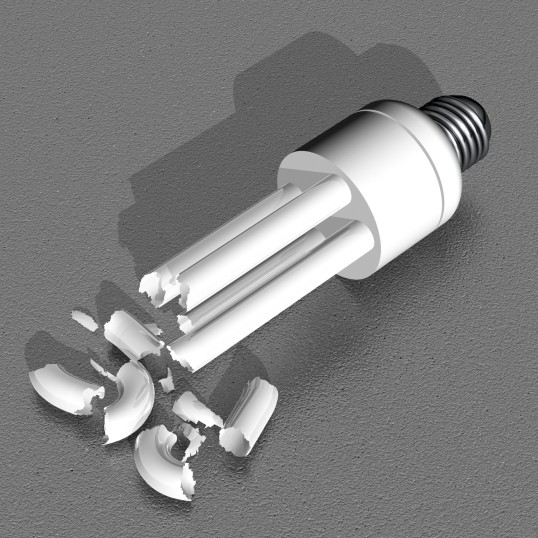- Elektromagnetic Fields
- Indoor workplaces
- Practical Solutions: Ergonomics
- Practical solutions: Hazardous substances
- Practical solutions: Noise
- Practical solutions: Machine safety
- Practical solutions: Personal Protective Equipment
Mercury in compact fluorescent lamps (energy-saving light bulbs) and fluorescent tubes

Broken energy-saving light bulb
Source: illuminator, fotolia
Compact fluorescent lamps (energy-saving lamps) and fluorescent tubes contain small amounts of mercury, which is required for the illumination process in these lighting products. The quantity of mercury that can be used in lamps is restricted in the European Union. Nevertheless, older fluorescent tubes (tubular lamps) may contain a multiple of the maximum quantity allowed. Since 2012, manufacturers have had to mark the mercury content on the packaging of the lamps. To minimise the risk of mercury exposure, any new lamps purchased should contain as little mercury as possible. Spent lamps must be disposed of at appropriate collection centres (e.g. recycling centres or retailers), not along with household waste, and breakage should be kept to a minimum.
No mercury is emitted from lamps when they are used as intended. However, when energy-saving lamps or fluorescent tubes are replaced or otherwise handled (when being collected for recycling, for example), there is a risk that they might be damaged. If they break, mercury vapours can be released.
Defective gas-discharge lamps should not be replaced when hot. The release of mercury vapour from lamps broken when hot is greater than when the lamps break in the cold state.
It is advisable for the room to be ventilated strongly for several minutes should a lamp break. Persons should leave the room whilst it is being ventilated. After waiting 15 to 30 minutes, they should then brush the lamp residue together carefully using strips of cardboard or paper, or collect it using adhesive tape. Disposable gloves should ideally be worn. Under no circumstances should a vacuum cleaner be used to collect the residue of broken lamps. All materials used are to be placed in a sealable container, such as a plastic bag or glass vessel with screw cap. The container is to be marked "Danger: may contain mercury residue from energy-saving lamps" and disposed of at the municipal waste collection points.
Measurements conducted by the German Umweltbundesamt on new energy-saving lamps on the market have shown that there are no significant concentrations of mercury following lamp breakages when the broken lamp is disposed of completely and the room immediately aired. Studies of mercury exposure following lamp breakage have also been conducted by the IFA in the project entitled "Mercury exposure caused by lamps and LCD devices".
For download

Further information

Contact
Hazardous substances: handling, protective measures
Tel: +49 30 13001-3320Fax: +49 30 13001-38001